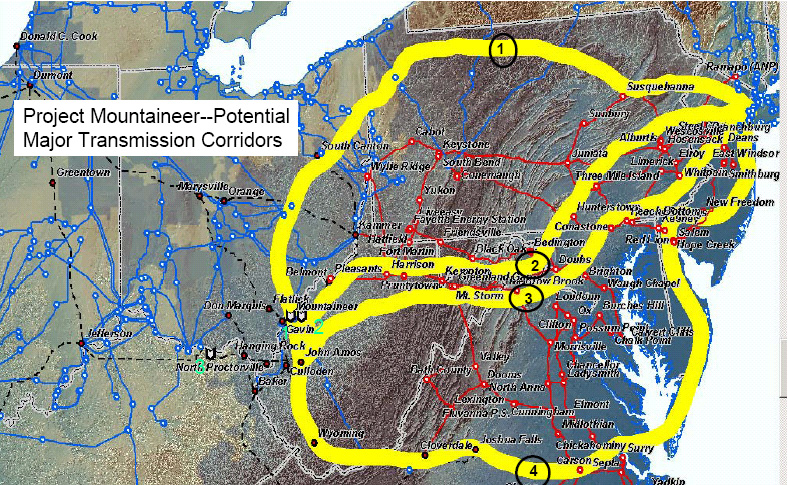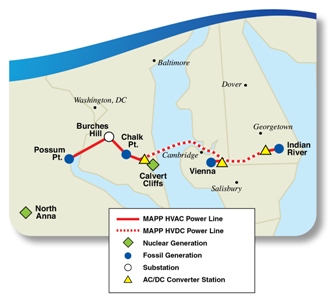MAPP is dead, dead, dead
August 8th, 2012
Just in today from PEPCO:
All,
I am writing to provide an update on PHI’s proposed Mid Atlantic Power Pathway (MAPP) project.
Today PJM issued the final results of its 2012 transmission analysis and due to factors such as lower load growth from the sluggish economy, the installation of new gas fired power plants, and the increase in demand response programs, no reliability violations were identified within the transmission planning window. As a result, the PJM Transmission Expansion Advisory Committee (TEAC) issued a recommendation that the MAPP project be canceled. On August 24, 2012, the PJM Board of Managers will meet to make a final decision on the TEAC’s recommendation.
I would like to express my sincere appreciation for your interest and participation in the MAPP project over the past few years.
Thank you,
Mark Okonowicz
MAPP – Environmental Coordinator
Pepco Holdings, Inc.
P – 302-283-6115
C – 302-463-5438
mark.okonowicz@pepcoholdings.com
This is after their bogus claims, in 2008, of skyrocketing peak demand (utterly unsupported by fact) from a June 25, 2008 MAPP Presentation found on the DNREC site — this “forecast” is so outrageous, and cancellation is SO HILARIOUS in light of Todd Goodman’s objections to my chalenging demand:
So let’s take a step back – what is MAPP?
No, this isn’t about the Mid-Continent Area Power Pool… it’s the Mid-Atlantic Power Pathway (MAPP), and it is DEAD!
The Mid-Atlantic Power Pathway, a transmission line that was part of “Project Mountaineer,” a coal transmission web that was hatched at a 2005 FERC meeting. MAPP was the NE part of line 4, below (Susquehanna-Roseland is the eastern part of line 1):
Here’s the transcript of that meeting, too scary, but it’s important to read this:
They tried and tried and tried, against evidence, to ram all these projects through. The did manage to get the first one through, the TrAIL (Trans-Allegheny Interstate Line) project, but PATH (Potomac-Appalachian Transmission Highline) is dead, Susquehanna-Roseland is permitted but not yet built…
Slowly but surely, PJM is admitting that transmission is not “needed” by any measure. With MAPP, first they planned it as above, in the first map, and then they eliminated the part in Delaware from Indian River to Salem/Hope Creek nuclear plants:
Despite this, Delaware’s DNREC issued permits for part of this project in Sussex County, Delaware! Whatever for? Why would they do this? Aren’t they paying attention to things electrical? DNREC should know this is not needed
Here is today’s good news — PJM’s latest review, just released, showing NO THERMAL VIOLATIONS — DUH:
Here are two slides that say it all, the first focused on PATH but including MAPP, and the second, the “MAPP Project Analysis” results:
And the bottom line? Another DUH, GOODBYE PATH AND GOODBYE MAPP:
Once again, we’re proven right. How long have we been fighting all these transmission projects, how much time, effort and money showing it’s not needed, even when using INDUSTRY studies, documentation, forecasts. All their claims of need are fabricated, reverse-engineering to get the result they want, billions of dollars of PRIVATE INTEREST, not PUBLIC interest, projects, built on the backs of landowners, with a FERC guaranteed 12+% rate of return for the owners/builders/developers.
The down side is the ratepayers are probably going to be hit with all these development costs because so many jurisdictions allow recovery for “CWP,” construction work in progress. So we get screwed, but not as badly as if they had built the projects.
Like CapX 2020, this project was another of those personal projects. MAPP was originally heading up through Delaware to the Salem/Hope Creek nuclear plants, and the Delaware part would have gone near us in Port Penn, we’re right across the Delaware River from Salem/Hope Creek. They should know better than to try something like that!
Delaware “Energy Plan” Comments due TODAY
March 15th, 2009
The Delaware PSC in action, May 2007, saying NO to NRG’s coal gasification proposal.
Delaware’s “Governors Energy Advisory Council” of Toadies and Lobbyists has published what’s called an “Energy Plan.” It’s pretty awful, a hodgepodge of random thoughts that has no budget allocated. It sounds like it was written by Delmarva Power and NRG. So what will happen? Not much, given its stream of unconsciousness ramblings — the justifications below each recommendation are sometimes utterly nonsensical … BUT… that’s what they put out.
COMMENTS ARE DUE TODAY! I know, Sunday, that’s weird, but when Alan called about it that’s what they said, so…
Check the plan and write up something QUICK and send it to:
DNREC settles with NRG for ~ $1.00 per violation!
January 8th, 2009
Horse’s Ass Award to DNREC’s John Hughes and (not-soon-enough) outgoing Gov. Minner (can’t have Delmarva Power’s Todd Goodman thinking he’s the only one!):
Let’s think a bit here… why this settlement? What would make it worth their while?
NRG has been belching pollution forever, violating federal rules, violating the Clean Air Act. For years this has been an issue, Green Delaware at the head of the charge. There’s been building attention and recently, Citizens for Clean Power filed Notice of Intent to Sue (below). And now, at the last minute of the Minner administration, DNREC does a deal with NRG that is so slimy, rolling over in a way that is less than a slap on the wrist to NRG and which could be just barely enough to prevent a suit by Citizens for Clean Power. And what if this had been filed at the END of November to put Markell on notice that he was expected to act, taking away that power to do an end run from Minner’s administration?
Here’s the 60 day notice filed on behalf of Citizens for Clean Power:
Here are some Green Delaware Alerts about NRG’s Indian River Power Plant:
And from the Archives:
Green Delaware Alert 238 – Minner administration proposes reduced reporting of SO2 releases
Green Delaware Alert 302 – Where does Delaware’s mercury come from?
Green Delaware Alert 499 – What problems are fundamental? Will our legislators tackle them?
Green Delaware Alert 506 – A decision time for power plant pollution in Delaware
For more from Green Delaware on NRG, go to www.greendel.org and search for NRG
From the News Journal yesterday and today:
This came over the wire today from Pat Gearity, Citizens for Clean Power, who have been leaning hard on NRG, that’s their mission:
Dear supporters of clean air:
Two months ago, CCP filed a 60-day Notice of Intent to Sue NRG’s Indian River Power Plant for over 5,000 violations of federal law from 2004-2008, including exceedances of nitrous oxide emissions and the opacity standard (a measure of particulate density discharged from the stacks). By law, DNREC and Governor Minner were also notified. Yesterday, DNREC announced its own lawsuit against NRG for the very violations CCP has alleged and that the agency has done nothing about since 2004. Why did DNREC take this action exactly 60 days before CCP could file its lawsuit? BY ENTERING INTO A TOKEN SETTLEMENT WITH NRG, DNREC AND JOHN HUGHES ALSO ATTEMPT TO BAR THE FILING OF CCP’S LAWSUIT.
On what basis did NRG Indian River solicit DNREC’s legal action to stop CCP’s impending citizen suit? Under the Clean Air Act, “diligent prosecution” in a court by a state agency precludes a private citizen suit if the agency files before the citizen suit can be filed.
On his way out the door, John Hughes took care of NRG again. Under a citizen lawsuit, IRPP could have been fined as much as $32,500 per violation and could have been ordered to pay additional funds to mitigate the environmental damage. Instead, the Secretary and the Agency stepped in to try to stop us for $1.00 per violation and a few token changes, with no environmental mitigation penalties.
NRG’s profits from IRPP make it a mega-million $ “cash cow” for the company. DNREC’s attempted interference with citizen’s rights is disgraceful. Change is desperately needed at DNREC. Please write Governor-elect Jack Markell at: Jack Markell <campaign@markell.org> or call him at 302 672-6700. Ask him to appoint a Secretary who will put public health, safety and corporate accountability above industry profit.
Please forward this email to interested persons. CCP’s 60-day Notice Letter to NRG is attached FYI.
Pat Gearity, Citizens for Clean Power
CITIZENS DECRY DNREC ATTEMPT TO PREVENT PRIVATE LAWSUIT AGAINST INDIAN RIVER POWER PLANT
LEWES, DELAWARE, January 7, 2009 – Citizens for Clean Power charged today that the Delaware Department of Natural Resources and Environmental Control (DNREC) is attempting to bar the filing of a private citizen lawsuit against the NRG-owned Indian River Generating Station (IRGS) for over 5,000 violations of the federal Clean Air Act since 2004, by filing its own lawsuit and pursuing only nominal penalties from the company.
On November 6, 2008, the Mid-Atlantic Environmental Law Center, representing Citizens for Clean Power (CCP), provided notice of intent to sue NRG affiliate Indian River Power, LLC, the operator of the power plant (IRGS) in Millsboro, Delaware. On January 5, 2009, one week before CCP could file its case by law, DNREC filed its own lawsuit against Indian River Power. DNREC’s suit mirrors the charges made by CCP. CCP’s notice letter charged that IRGS has violated provisions of the Clean Air Act, its Title V Operating Permit, and the emission limitations in various federal and state rules
and permits. The letter identified violations of state and federal opacity standards and nitrogen oxide standards from all four operating units at the plant. In its notice, CCP alleged that IRGS committed more than 4400 opacity violations and 771 violations of nitrogen oxide standards dating to 2004, and indicated the suit would seek financial penalties and injunctive relief to ensure future compliance.“We have complained to DNREC about the pollution from this plant for years, but until our lawsuit approached, DNREC consistently declined to enforce the law,” William Zak, co-founder of Citizens for Clean Power, said. “Despite Indian River Power Plant being the biggest polluter in the state, DNREC has now essentially acted on the plant’s behalf to halt the meaningful deterrence and compliance-inducing injunctive relief we would seek through our suit,” Zak continued.
Each time that Indian River violated its permit and the underlying regulations a separate violation of the Clean Air Act occurred. Under a private citizen lawsuit, each violation can result in maximum civil penalties of up to $32,500. Proceeding under state law, DNREC’s suit indicates it is authorized to seek financial penalties against the plant between $1,000 and $10,000 per violation. But the reality is
far, far lower. The filed Consent Order from DNREC, agreed to by Indian River Power, features a $5,000 penalty, along with other minor requirements.“The pattern of opacity non-compliance at Indian River is so extensive that only significant penalties designed to deter future violations and an upgrade in particulate matter pollution controls will resolve the situation,” said Michael Fiorentino of Mid-Atlantic Environmental Law Center, Counsel to CCP. “At less than a dollar per incident, violating the Clean Air Act has never been this cheap.”
Zak was outraged by word of DNREC’s settlement. “It’s a major slap in the face to the public and particularly to the citizens of eastern Sussex County, who have been breathing toxic pollution from the Indian River plant for more than fifty years, with little or no advocacy by the one state agency charged with protecting them,” Zak said.
——————-
——————-
As Pat Gearity reports, they’re not done with this yet… stay tuned for the rest of the story!







